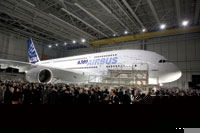
A president and four prime ministers lauded the A380 Airbus super-jumbo at its unveiling in Toulouse – but it will be Emirates, the Dubai based airline, which will dominate the skies once this monster aircraft starts flying.
Emirates was the first buyer and will be the largest operator of the A380 with 45 aircrafts on order – 43 of the passenger version and two freighters.
Emirates expects to introduce the aircraft into service in October next year, followed later by Etihad Airways who have ordered four aircraft, from 2007, and Qatar Airways in 2009, who have ordered two of the type. Emirates A380 will carry more than 500 passengers in a three-class configuration.
The hundreds of press and TV journalists, who gathered in Toulouse asked Emirates: “Why so many?” HH Sheikh Ahmed bin Saeed Al Maktoum, chairman of Emirates, said with a chuckle: “We could fill them, if we had them now.”
Sheikh Ahmed continued: “This aircraft is a key element in Emirates’ future growth. Air travel is forecast to double in the next 14 years. There are continued restraints on traffic rights and the availability of landing slots – and, therefore, large capacity aircraft will be vital to Emirates’ need to meet the increasing passenger demands. The A380 is the future of air travel.”
In addition to the largest order for the aircraft, Emirates also became the biggest purchaser of the GP7000 engine, produced by GE Aircraft Engines and Pratt & Whitney’s Engine Alliance.
In fact, with all the other aircraft still to be delivered, including 20 Airbus A340-600 and 27 Boeing 777-300ERs, Emirates has more than $30 billion worth of jetliners on order.
Although Emirates has been secretive about the facilities which will be available for passengers in the A380, a few facts have already leaked out. The First Class cabin will be fitted with mini-suites, similar but lager than those on the current long-range A340-500s ($80 million worth of suites on order). There will also be state-of-the-art in-flight entertainment systems supplied by Matsushita called “cx2”, which has set Emirates back another $1 billion.
In the meantime, Dubai International Airport is preparing to receive the double-decker aircraft at its new Terminal 3, which is expected to open in time to receive the first Emirates A380, and will have 23 departure gates and aerobridges for two-tier boarding and disembarking.
Emirates has not yet announced the first routes on which the A380 will operate, but it is expected that trunk routes such as between Dubai and Europe and Dubai and the Far East will see the first service.
As well as building a new passenger terminal capable of handling the A380, Dubai International Airport is also building a mega cargo terminal designed to increase cargo capacity to one million tones per year, which will be able to handle the A380 freighters.
Emirates’ A380F will have three decks and will be able to carry payloads of 150 tonnes over a range of 10,400 km and will be entering services in 2008.
The last word goes to Sheikh Ahmed: “By 2012, our current 73-strong fleet will more than double in size, enabling us to carry a lot more than twice the present number of passengers, because the average size of our aircraft will be substantially bigger. We are trying to make flying experience enjoyable again and the A380 will be a great tool in support of this goal.”
